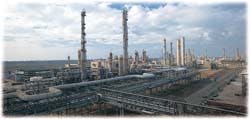Thi Chang
Refining/Petrochemical Editor
Reliance Industries Ltd., Hazira, India, started operating Asia's largest grassroots naphtha cracker in March 1997. The facility uses Stone & Webster Engineering Corp.'s proprietary Ultra-Selective Conversion pyrolysis technology. The cracker can produce 700,000 mty of ethylene and 350,000 mty of propylene. Photo courtesy of Stone & Webster.World ethylene capacity increased by 4.6 million metric tons/year (mty) to 89.6 million mty, according to Oil & Gas Journal's annual ethylene survey. This 5.4% increase came in spite of warnings of oversupply.
The survey, taken and compiled by Survey Editor Marilyn Radler, can be found on p. 48. It reports capacities of ethylene producers as of Jan. 1, 1998.
The Asia/Pacific (mainly South Korea, India, and Singapore) and North American regions each account for about 40% of this ethylene capacity increase. Table 1 [19,398 bytes] shows the worldwide capacity increases by region. The Middle East/Africa region also shows a significant capacity increase, 665,000 mty. Table 2 [45,306 bytes] shows the worldwide capacity listed by countries.
One new ethylene plant started up in 1997. In November 1997, Equate Petrochemical Co. started a 650,000 mty ethylene plant in Shuaiba, Kuwait. Equate is a joint venture between Union Carbide Corp. (45%), Kuwait's state-owned Petrochemical Industries Co. (45%), and Bubyan Petrochemicals Co. (10%) (OGJ, Dec. 1, 1997, p. 44).
Chemical plants with significant ethylene expansions in the past year and their additional ethylene capacities are:
- Indian Petrochemicals Corp., 300,000 mty increase, Nagothane, India
- Petrochemical Corp. of Singapore Pte. Ltd., 515,000 mty increase, Sing Pulau Ayer Merbau, Singapore.
- Mitsubishi Chemical Corp., 108,000 mty increase, Kashima, Japan
- Hyundai Petrochemical Co. Ltd., 550,000 mty increase, Daesan, South Korea
- LG Petrochemical Co. Ltd., 190,000 mty increase, Yeochun, South Korea
- Samsung General Chemicals Co. Ltd., 100,000 mty increase, Daesan, South Korea
- Chevron Chemical Co., 330,000 mty increase, Port Arthur, Tex.
- Exxon Chemical Co., 700,000 mty increase, Baytown, Tex.
- Westlake Polymers Corp., 590,000 mty increase, Sulphur, Tex.
New construction
Despite warnings of a weak market, several new plants and plant expansions are planned to be complete before 2000. According to OGJ's construction survey (OGJ, Oct. 13, 1997, p. 67), if all planned projects are completed, ethylene supply will increase by 15 million mty to about 103 million mty by end of 2000. Fig. 1 [77,336 bytes] shows that Chemical Markets Associates Inc. (CMAI), a consulting firm based Houston, expects demand in 2000 to be about 90 million mty.Increased ethylene investments are being made in the Middle East, Western Canada, Venezuela, and Mexico. CMAI, in its 1996/1997 World Olefins Analysis, points out that these expansions are attractive because ethane feedstock is low-priced in these areas and offers producers increased margins.
The Asia/Pacific region, mainly China, Taiwan, India, Malaysia, and Singapore, also plans significant increases in ethylene capacity for the year 2000.
To lower cost per unit of production, producers are building larger ethylene-cracking units (OGJ, Mar. 23, 1998, p. 52). Average light-olefins units produce at least 800,000 mty.
Asian crisis effect
The failure of the Thailand banking system last July, which resulted in the Asian financial crisis, is having a global impact on petrochemicals. Although the crisis leaves demand for petrochemicals weaker, analysts still predict demand growth. This growth, however, is slower than that of earlier projections.CMAI's 1997/98 World Light Olefins Analysis states, "Although growth for Southeast Asia in 1997 and 1998 will slow dramatically, prospects in the region remain strong."
To measure the effect of the Asian crisis, CMAI shows the difference between last year's projected Asian demand and this year's projected demand as "demand losses." Fig. 2 [29,430 bytes] shows the change in Asian demand forecast as a result of the crisis. In 1997, polyethylene demand was actually adjusted upwards from earlier predictions.
Polypropylene, however, saw a downward adjustment of about 100,000 tons. Beyond 1997, all demand projections were adjusted downward.
According to CMAI, weak Asian demand is causing several ethylene producers to look for other export alternatives. Canadian exporters and Middle East exporters are diverting exports that would have gone to Southeast Asia to the U.S. and Western European markets, respectively. CMAI predicts that because Canada and the Middle East are competitive producers, the U.S. will look to Latin America as a potential export channel, and Western Europe will endure lower operating rates (80-85%).
At Chem Systems' "Creating Value in the Chemical Industry" annual conference on Jan. 28-29, 1998, Bruce F. Burke, vice-president of Chem Systems, Tarrytown, N.Y., said, "The recent difficulties in Asia probably have improved the prospects for additional developments in the Latin region." Argentina, Brazil, Chile, and Venezuela plan world-scale olefin plants, and Brazil and Venezuela plan aromatic plants.
From an opportunist's view, the crisis lowered Asian petrochemical prices and makes Asia a competitive exporter. In addition, devalued Asian petrochemical facilities may be ripe for foreign investment. Indonesia's PT Peni polyethylene joint venture continues to plan its 900,000 mty ethylene plant in Bojonegara, West Java (OGJ, Nov. 17, 1997, p. 47). At the end of 1997, Thailand's Songkla Petroleum began plans to build a refining/petrochemical complex capable of producing 250,000 mty of polyethylene and 110,000 mty of butadiene (OGJ, Nov. 3, 1997, p. 34).
Ethylene
Good margins since 1995 encouraged ethylene producers to add capacity. Unfortunately, world capacity is now greater than demand, decreasing ethylene prices and thus margins. The cyclical nature of the industry, combined with excessive plant production in good times, have dampened the ethylene margins for the next 3-5 years.CMAI foresees the gap between demand and supply widening until 2002-2003. Fig. 1 shows this gap. The competitive world operating rates will fall to below 90% for 1999-2002, predicts CMAI.
At the Chem Systems conference, Kenneth M. Stern, managing director of Chem Systems, predicted a compound growth rate of 5.2%/year for ethylene demand between 1995-2005. By 2005, he predicts Asia, including Japan, will be the largest consuming region in the world, with 31% of the world demand.
Samuel W. Weinberger, planning manager for Exxon Chemical Co., said in a paper on the future of ethylene at the Chem Systems conference, that he expects ethylene capacity in Asia, particularly in China, to show the largest growth between 1995 and 2000 (Fig. 3 [32,449 bytes]). China's absolute ethylene capacity, however, is still much smaller than that of North America and Western Europe.
According to Stephen N. Rotham, vice-president of Chem Systems, China is and will continue to be a significant world importer of petrochemicals (Fig. 4 [31,407 bytes]). He said, "Without exception, it will encounter shortfalls in every one [ethylene, polyethylene, polystyrene, polypropylene] of the products just reviewed-even with the projected new capacity-at least through 2005."
Fig. 5 [27,364 bytes] shows decreasing ethylene margins until 2000, then cycling margins until 2010. According to Stern, in the next few years, ethane-feedstock ethylene producers will feel less pressure than naphtha-feedstock ethylene producers.
According to Weinberger, ethane used for U.S. ethylene feedstock, will grow about 80,000 b/d. The supply will be recovered from offshore gas being produced in the Gulf of Mexico and processed in Louisiana. Fig. 6 [28,997 bytes] shows the predicted U.S. ethylene feedstock mix to 2005.
In general, CMAI predicts that global ethylene and derivative markets will not recover until 2002-2003. For the U.S. and Western Europe, CMAI predicts that ethylene prices will weaken through 1998-1999, and recover by 2003 at the latest.
With declining prices and margins, ethylene producers will look for strategic cost-saving measures. CMAI predicts the occurrences of mergers and divestitures will be greater than that seen in the last down cycle (1990-1993).
Propylene
The CMAI study concludes that propylene production will need to increase to meet demands. Propylene is a coproduct of either motor gasoline (from the fluid-catalytic cracking unit) or of ethylene, and its demand growth exceeds them both."As a result, propylene prices will have to be relatively higher in the future in order to help justify greater use of 'on-purpose' propylene production or new technologies to enhance existing propylene production," states CMAI in the 1997/98 World Olefins Analysis.
To increase propylene supplies, companies are investing in processes that increase propylene production. China and Thailand have invested in deep-catalytic cracking units (OGJ, Jan. 12, 1998, p. 49).
David Glass, director of Chem Systems Ltd., London, pointed out several additional construction projects aimed at increasing propylene supplies.
BASF and Fina announced plans to build a steam cracker in Texas using integrated metathesis to maximize propylene vs. ethylene. Lyondell has operated a metathesis unit in Channelview, Tex., since 1985.
Mineralölraffinerie Oberrhein GmbH plans to build a metathesis reactor to make propylene in its Karls ruhe, Germany, refinery.
Using olefin metathesis, n-butenes can be reacted in the presence of ethylene to make propylene.
Europe, Asia, and Mexico also have propane dehydrogenation plants for propylene production.
The shortage of propylene has led to a seller's market. According to Glass, the propylene shortage is so extreme that "plans to build and expand propylene derivatives have been announced without full agreement on the source of propylene." Fig. 7 [23,302 bytes] shows projected regional propylene demand growth 1996-2000. Global demand growth is expected to be about 6% during this period.
Fig. 8 [21,993 bytes] shows Latin America, Western Europe, and Southeast Asia to be net import countries by 2000. Their domestic propylene demand exceeds their supply.
Polyolefins
Robert Bauman, vice-president of Chem Systems, said at the conference that the leading companies are backwards integrating ethylene feedstocks with their polyolefin processes to remain competitive.While 60% of North American polyethylene producers held their ethylene captive in 1990, Bauman predicts 87% will have their own ethylene supply in 2000. Similarly, the percentage of ethylene supply captivity for North American polypropylene producers is expected to move from 60% in 1990 to 69% in 2000 (Fig. 9a [32,622 bytes]) and (Fig. 9b [71,574 bytes])
Harry J. Hyatt, managing director of Sasol Alpha Olefins, at the recent Chem Systems conference, showed figures that charted the supply/demand balance of hexene and octene (Fig. 10 [54,070 bytes] and Fig. 11 [58,041 bytes]). These alpha olefins, comonomers for polyethylene, unlike ethylene and propylene, seem to have a matching supply and demand through 2001.
Bauman, however, predicts an undersupply of C6 to C10 and an oversupply of C12+ by 2005.
According to Bauman, the future for polyethylene is oversupply. There is a planned additional 18.3 million mty of capacity for 1998-2001, 38% of it to occur in Asia, 20% by the U.S., and 20% by North America. He predicts polyethylene prices falling through 1999.
In a presentation at Chem Systems, Don Bari, vice-president of Chem Systems, pointed out that catalyst technology will increase the linear low-density polyethylene (LLDPE) penetration of the LLDPE/LDPE market from 20-65% to 75% by 2010.
According to CMAI, low-density polyethylene (LDPE) is growing at a worldwide rate of less than 2% a year. Most of its growth has been substituted by LLDPE demand. LLDPE growth, on the other hand, is projected to grow about 10%/year.
Per CMAI's olefins analysis, high-density polyethylene (HDPE) growth is estimated to be 6.0%/year. Much of this growth is expected to come from molding applications (blow molding and injection molding) as well as high molecular weight film for bag and pressure pipe for industrial uses.
Polypropylene predictions are like that of polyethylene-oversupply in the near future. Bauman predicts an increase of 11.6 million mty from 1997 through 2001; 39% of that increase will come from Asia. CMAI thinks that 2.0 million tons of new capacity is targeted for Western Europe and the Middle East where propylene supplies are limited.
Global polypropylene demand is expected to grow at nearly 8.0%/year through 2000, according to Bauman.
Copyright 1998 Oil & Gas Journal. All Rights Reserved.


